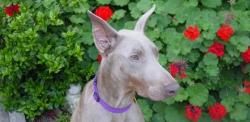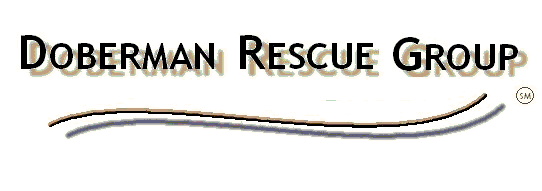

Home
Contact Us
Adoptable Dogs
Adoption Information
Our Store
About the Breed
Fundraisers
News
Happy Tails
Rainbow Bridge
Related Links
The Doberman Rescue Group is funded solely by donation. We love and care for Dobermans in need. You can even donate using PayPal. It's quick and easy, just follow the link above.
All materials on this site, text, images, and otherwise, are the property of Doberman Rescue Group, Inc (DRG). The use of these materials without the express permission by an authorized DRG officer is theft and can result in legal action. By visiting this site, you agree to these terms.
Copyright (c) 2005
We hope everyone researches and understands about any animal they are interested in having as a companion. It is quite possible that our animal rescues and animal shelter would be less crowded if people took time and educated themselves before choosing a breed, rather picking a breed based on looks or other preconceived notions.
Physical Attributes
The Doberman breed has a wide array of physical attributes, which stem from their mixed heritage.
General:
The appearance is that of a dog of medium size, with a body that is
square. Compactly built, muscular and powerful, for great endurance and
speed. Elegant in appearance, of proud carriage, reflecting great
nobility and temperament. Energetic, watchful, determined, alert,
fearless, loyal and obedient. Often, Dobermans have very short
hair that lays close to their bodies. Although, longer hair breeds
do exist.
Color:
Black and Tan is the most common. The body is mostly black with accents of tan (rust) around the feet, chest, and face. Dobermans can also be found in Red, Fawn, and Blue. Reds are a reddish tan body with the common tan color found around the feet, chest, and face. Fawns are a lighter brown color also with the tan accents around the feet, chest, and face. Blues will appear as a bluish grey color and will also have tan accents around the feet, chest, and face. The final color is the Albino, which are mistakenly sold as white Dobermans. Quick note about "white" Dobermans. The white Doberman is considered an incomplete or partial albino. The dogs have blue eyes and are cream colored with light tan markings. They suffer from photo phobia (photosensitive), meaning the dog cannot tolerate light, often closing their eyes and bumping into objects when put in unfamiliar surroundings. Their temperaments range from being very shy to fear biters. These are not the attributes a responsible breeder or one that is familiar with the criteria of a working dog wish to produce or perpetuate. White Dobermans are NOT considered to be of great value (charging more/more expensive) by Responsible Breeders. Responsible Breeders DO NOT include the white Dobermans in their breeding stock/programs.
Size:
Height at the withers: Male Dogs 26 to 28 inches; Females 24 to 26 inches
Weight: varies between 50 - 100 pounds
Feeding and Care
Feeding:
Many Doberman breeders recommend a lower protein puppy food (less than 28%) for the first months of puppy hood. They also discontinue feeding puppy food at an early age, ~4 months. This practice is thought to help reduce the incidence of Panosteitis (wandering lameness) and reduce the rapid growth produced by a higher ratio of protein found in most commercial puppy foods. Many also recommend raising the food dish off the floor to lessen neck strain while feeding.
Adult Dobermans should be an adult dog food containing "joint support" supplements, such as glucosamine, to help reduce the risk of hip dysplasia.
A typical and health adult Doberman can eat nearly 40 pounds of dry dog food a month, which can mean an average of $20 per month per dog. As a Purina "Rally to Rescue," we feed and recommend the Pro Plan brand dog food.
Water:
All mammals need water. Like in feeding, raising the water dish off the floor will help lessen neck strain. Also, water quality is important. Just like human consumption of tap water is a health concern, the same contaminates can affect your dogs well being. If at all possible, your dogs should be give water that is filtered. If filling a water dish from a garden hose, remember to allow the water to run through the hose for a few minutes, because harmful germs and bacteria grow in the stagnant water left in a hose.
Toys:
The Doberman is likely to be able to destroy most toys suitable for other breeds. One safe bet is a Kong toy which is fairly indestructible. We also recommend toys from Helping Udders. Dobes also have a love of tennis balls but these should only be provided with supervision. There are known cases of Dobermans choking on tennis balls. Beware of products stating they can be "ingested" safely. This DOES NOT mean they can be digested successfully.
Misconceptions
Among the top of the list of common misconceptions is all Dobermans are aggressive dogs. Most breeder and Doberman organizations view aggregation as a negative trait. In turn, most breeders are breeding kinder and gentler Dobermans. The stereotypical savage Doberman guard dogs in the movies is an unfair and characteristic view of this breed.
Health Problems
Dobermans are susceptible to:
- acne/hair pore infections
- anondontia
- hip dysplasia
- von Willebrand's Disease
- bloat
- immune-deficiency disorders
- severe heart disease (Cardiomyopathy)
- thyroid disorders (Addison's Disease)
- liver disorders (Leptospirosis, Renal cortical hypoplasia)
- chronic active hepatitis (copper toxicosis)
- Color Mutant Alopecia (Blue Doberman Syndrome)
- dandruff
- Panosteitis (wandering lameness)
- Urinary Incontinence
- spinal disorders (Wobber's, Intervertebral Disk Disease)